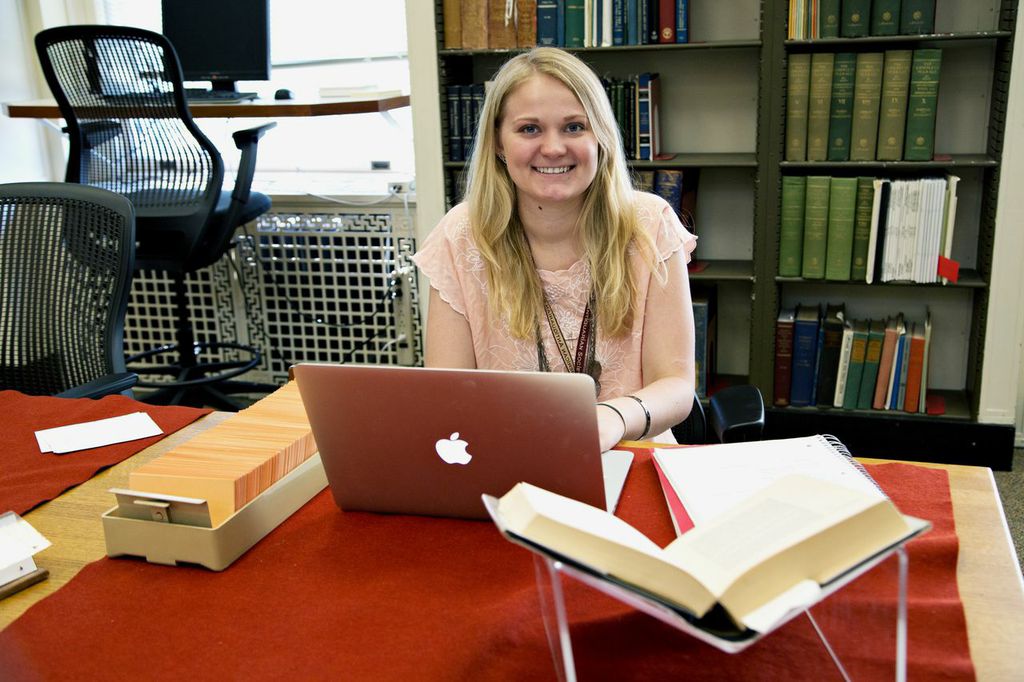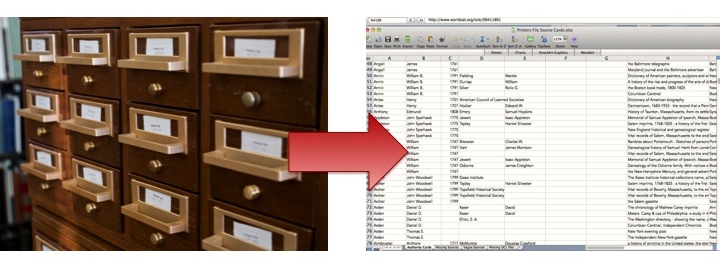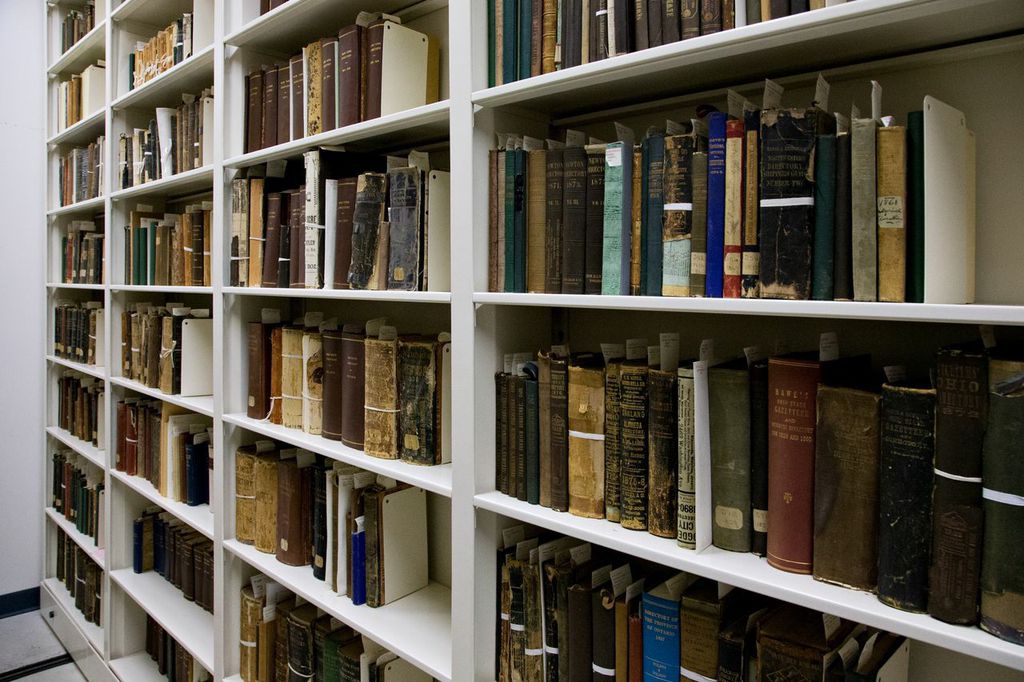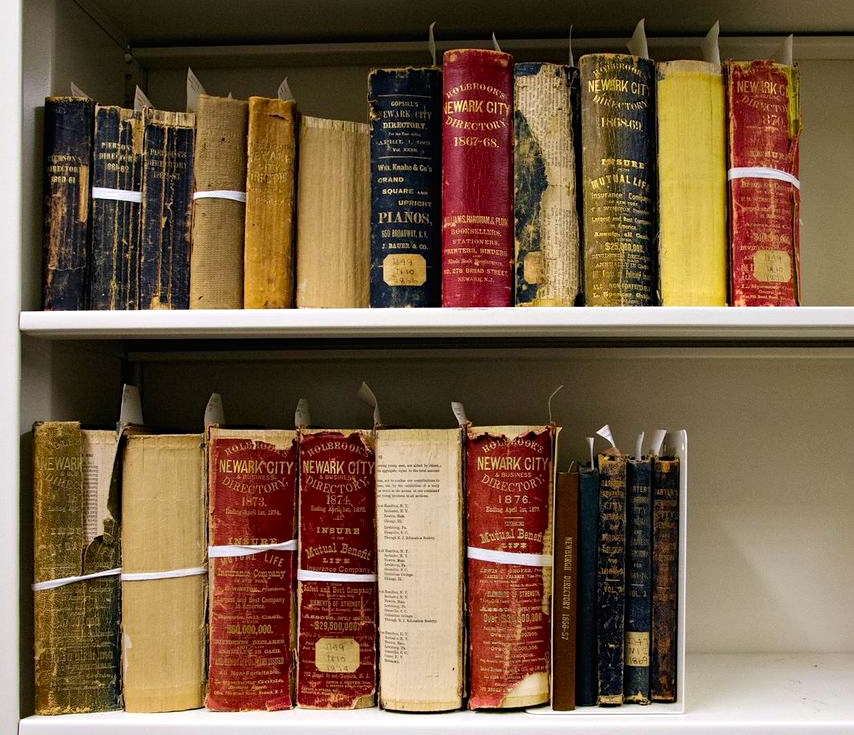Samantha Cook is a senior at the University of Wyoming where she is majoring in History and Museum Studies. She spent last summer on an archeological dig in Italy, and this summer, she has been with us at AAS as a catalog camper, doing a completely different kind of digging.

When I made the bold decision to move from small town Wyoming to the second largest city in New England for a summer of catalog camp at the AAS, I did not know what to expect, being that there were so many unknowns: how would I like my job? The people? The institution? The city? I am fortunate that I have been handed a wonderful project, friendly co-workers, and the ability to learn about numerous topics so that my brain is happy and full. My time here learning the ins and outs of being a research detective and figuring out mysteries left behind by a brilliant cataloger has been one of the best experiences in my life.
The Printers’ File is well known to many people who come to visit the reading room, and many early Americanists and book historians eagerly await its incarnation as a relational database. The effort to create this digital resource brought me from Laramie, Wyoming, to Worcester, where I now spend my days sifting through the copious amount of information collected by Avis Clarke.
Clarke was the first trained cataloger here at AAS, and I look up to her for her dedication and the patience that she must have had while building the Printers’ File. From 1927 to 1970, Clarke spent each Wednesday looking through books, directories, letters, and newspapers as she gathered biographical information of people in the book and related trades from 1640 to 1820. Clarke searched by hand through these books, not having the technology we have today; on multiple occasions I have turned to Molly Hardy, curator of digital humanities and the project’s manager, wondering how Clarke sat there and built this amazing resource over so many years. Molly and I regularly find occasion to marvel at her perseverance as I look through these cards finding the authority or source cards where Avis listed the myriad materials she consulted. I have been transforming Clarke’s sources into an Excel spreadsheet (see below), which will then be transferred to tables in a MySQL database.
 Working with these cards has led me to try to think like Clarke, to figure out her shorthands and abbreviations, and in some instances to re-research her sources. There have been numerous times that I have felt frustrated with Clarke for her shorthand notations that left me to deduce what she may have meant. I can sometimes see Clarke laughing at my struggles as if she were still here.
Working with these cards has led me to try to think like Clarke, to figure out her shorthands and abbreviations, and in some instances to re-research her sources. There have been numerous times that I have felt frustrated with Clarke for her shorthand notations that left me to deduce what she may have meant. I can sometimes see Clarke laughing at my struggles as if she were still here.
The mysteries left for me to unravel include what Clarke might have had in mind in her more enigmatic citations. At the start of my time here, I came across a source that said, ‘Letter from Elmer T. Hutchinson, New Jersey Historical Society, January 5, 1946.’ When I realized that this was a manuscript, I was still not sure how to find it because, as I learned, manuscripts in archives are rarely cataloged at item level. Members of the AAS staff were soon able to direct me to AAS archives to find the letter. In reading the letter, I eavesdropped on the friendship between Clarence Brigham and Elmer T. Hutchinson, who not only exchanged information on printers, but also shared their reading pleasures with each other making it clear they were friends as well as colleagues. Because Clarke includes this letter in her sources and because I have included it in the Excel spreadsheet, complete with a link to the AAS Records, which date back to 1812, many others will be able to not only find the source of this information, but will also bear witness to this friendship based on a shared enthusiasm for printers and books.

Part of what has amazed me so much as I retrace Clarke’s path is the staggering range of sources she consulted: letters, books, newspapers, genealogies, and archive collections. But the source that stunned me the most were the directories from different cities in the United States.
Clarke had to go through year-after-year looking for different names to find information on people in the book trade. She consulted a staggering number of directories to complete her research. Clarke would often list 15-20 consecutive years on the same cards. From those sources it has been remarkable to see the vast differences between each directory from different cities or  states. These directories are easily the most used source by Avis, making up a third of the total expanse of sources used, though the citations can at times be rather vague. Instead of citing “New York directories from 1801-1810,” she might only write “New York directories.” She also once cited “New York directories 1810-1815 and more.” This led to frustrations because it was impossible for me to determine the specific dates she intended as sources. But, with these as my biggest frustrations, this project has been a delight.
states. These directories are easily the most used source by Avis, making up a third of the total expanse of sources used, though the citations can at times be rather vague. Instead of citing “New York directories from 1801-1810,” she might only write “New York directories.” She also once cited “New York directories 1810-1815 and more.” This led to frustrations because it was impossible for me to determine the specific dates she intended as sources. But, with these as my biggest frustrations, this project has been a delight.
Having to speculate what Clarke might have meant by certain sources is something that I have learned to do over time here and my love for the Printers’ File has only grown along with that time. At the end of this summer, I will dearly miss the Printers’ File, my co-workers, and fellows at AAS, but I am proud of helping to lay the groundwork for the Database of the Early American Book Trade.
